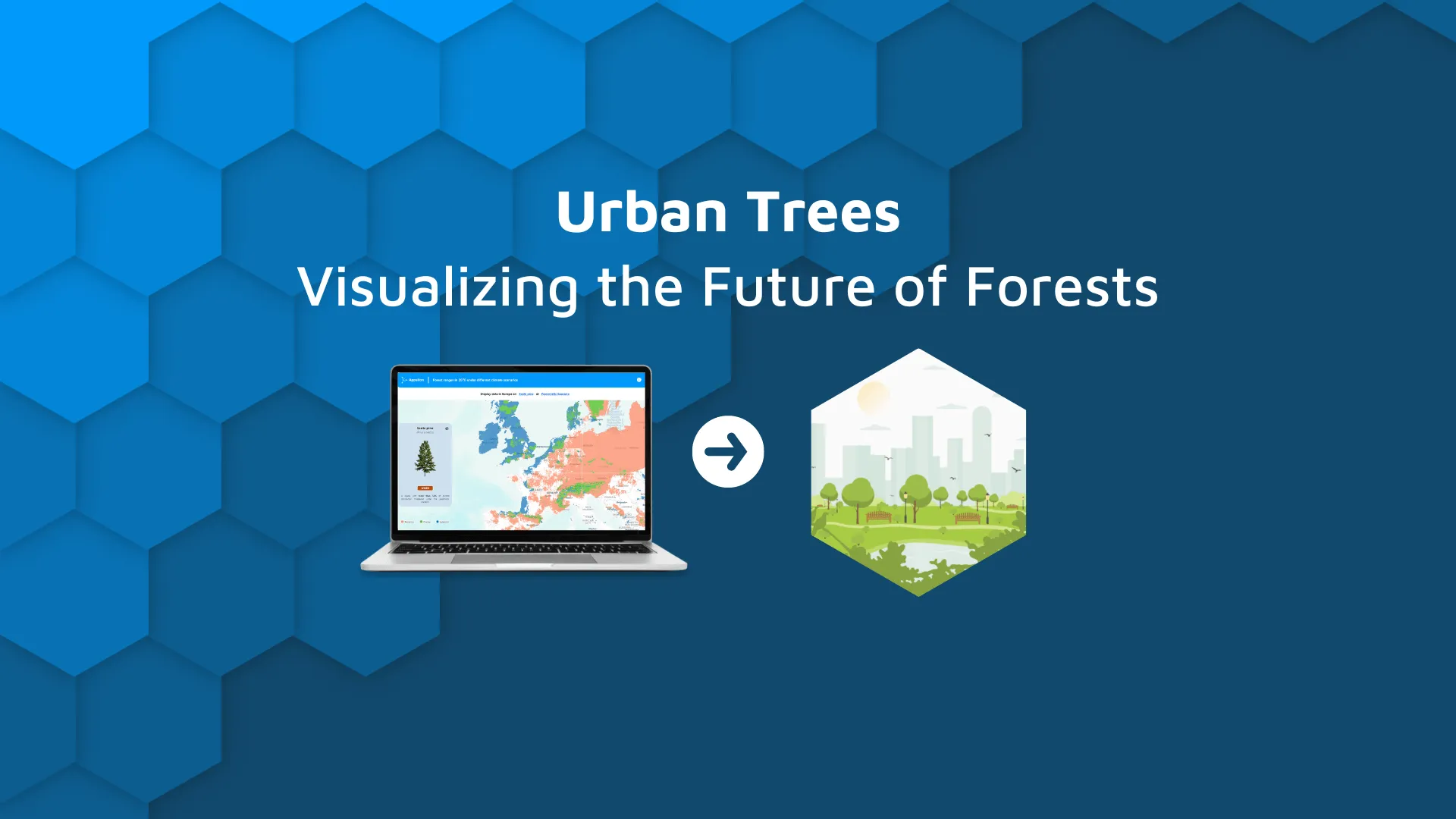Urban Trees: Visualizing the Future of Forests

Urban trees. They increase property values. They break up the concrete skyline. And they clean our air. These trees planted and maintained in our cities, provide a great service. But what's the cost of planting trees in our cities? And are these long-term investments future-proof? <img class="wp-image-16773" src="https://webflow-prod-assets.s3.amazonaws.com/6525256482c9e9a06c7a9d3c%2F65b01c86307dbcdd40ae32dc_sophie-nito-qJsTwXgmguk-tny-scaled.webp" alt="Aerial view of trees on park to the left and trees in residential area on the right" width="500" height="333" /> Aerial view of urban trees in a park and residential area (image credit: <a href="https://unsplash.com/@sophienito?utm_source=unsplash&utm_medium=referral&utm_content=creditCopyText" target="_blank" rel="nofollow noopener">Sophi Nito</a>) <h2>Urban trees and climate change</h2> Obviously planting trees in urban areas is important. But how are they beneficial in the big picture? Are they combatting climate change or just mitigating its effects? The quick answer is, "yes." They act as carbon sinks, and yes they help mitigate some effects like warming temperatures. But there are some caveats. <h3>Trees and urban heat islands</h3> Trees absolutely help diminish the urban heat island effect - the annual summertime topic for urbanites everywhere. If you live in a city, you know well enough that the summer heat bakes you from above and below, soaking into the concrete jungle and radiating everywhere. It's hot! Trees provide that respite. <img class="size-full wp-image-16771" src="https://webflow-prod-assets.s3.amazonaws.com/6525256482c9e9a06c7a9d3c%2F65b01c865526ddbe52f9586c_Urban-Heat-Island-Effect.webp" alt="Urban Heat Island Effect graph showing the response temperature over correlating surface features " width="699" height="357" /> Urban Heat Island Effect diagram (image credit: <a href="https://www.researchgate.net/figure/Urban-Heat-Island-Effect_fig1_352786126" target="_blank" rel="nofollow noopener">Lasantha K Weerasinghe</a>) Trees, and other vegetation, help mitigate heat island effects by shading those heat-absorbing surfaces and deflecting some of the Sun’s radiation. They also release moisture into the atmosphere, but this can be a “catch-22” as there is a <a href="https://www.nbcnews.com/health/health-news/it-s-not-just-heat-it-really-humidity-know-risks-n629486">negative effect humidity</a> can have in making us feel hotter. <h3>Urban forests and pollution</h3> Contrary to popular belief, urban forests, or large groupings of trees in areas like parks, can have a <a href="https://www.sciencedirect.com/science/article/abs/pii/S0269749112004605?via%3Dihub">negative impact on air pollution</a>. This is not to say that they don’t help capture greenhouse gases or ‘filter’ particulates in the air - they do. But if you were to stroll through a park in the polluted airs of Beijing or Krakow, you’d be better off walking through the open airflow of a grassy gnoll than the still-air, particulate-laden forest. Side note: You might be wondering why grasses aren't planted in place of trees, especially if higher concentrations of particulates are found among the forested areas. Well, <a href="https://caes.ucdavis.edu/news/articles/2018/july/grasslands-more-reliable-carbon-sink-than-trees" target="_blank" rel="nofollow noopener">grasslands are more reliable carbon sinks</a> than forests and with greater adaptive value, so planting things like bluestem, golden oat, or other native grassland species is important. But, in short, trees have unique characteristics that provide benefits for urban areas and perform well on a smaller scale. Both are good landscaping options, but one should not be sacrificed over the other - especially in the context of a changing climate. <blockquote>Curious how your country fares for air pollution and respiratory illness? <a href="https://appsilon.com/appsprints-r-shiny-app-development/">Explore this R Shiny dashboard for visualizing air pollutants across the globe</a>.</blockquote> <h4>Urban trees vs rural forests</h4> While we’re on the topic of urban trees and air pollution. We should talk about how that air actually gets ‘cleaned.’ Most removal of air pollution and subsequent benefits to urban areas actually <a href="https://www.sciencedirect.com/science/article/abs/pii/S0269749114002395" target="_blank" rel="nofollow noopener">occurs in rural forests</a>, where the bulk of particulate matter is intercepted on plant surfaces and harmful gases are absorbed. Trees, both rural and urban, “capture” particles, odors, and gases as they flow through the air. The gases and really fine particles are filtered through the stomata of the leaves. But the larger particles, the PM10 and PM2.5, that you might see on your local weather channel, aren’t actually filtered. Rather, airflow slows down enough as it passes through and the particles settle on the surface of leaves, bark, or on the ground. <h2>The business of urban forestry</h2> Trees are expensive and urban forestry is a big business. In some cases, the estimated annual cost per tree can reach <a href="https://www.researchgate.net/publication/233511176_Municipal_Forest_Benefits_and_Costs_in_Five_US_Cities">upwards of $100</a> (adjusted for inflation). And for a tree’s benefits to outweigh its costs, it needs to survive roughly two decades. There are nearly <a href="https://www.fs.usda.gov/research/treesearch/55818#" target="_blank" rel="nofollow noopener">5.5 billion urban trees in the United States</a> alone; that’s a significant investment for municipalities and their taxpayers. But as the research shows, the return on investment is well worth it - assuming the planted tree survives long enough to see that environmental and monetary ROI. If the trees planted are to survive long enough to be “cost-effective”, arborists need to: <ol><li>Select the right tree for the right location and </li><li>Monitor and maintain that tree over its lifetime. </li></ol> With so many popular initiatives like <a href="https://teamtrees.org/" target="_blank" rel="nofollow noopener">Mr. Beast’s #TeamTrees</a> and <a href="https://www.mossy.earth/projects" target="_blank" rel="nofollow noopener">Mossy Earth’s reforestation projects</a> to EU-funded projects like <a href="https://www.lifeurbangreen.eu/" target="_blank" rel="nofollow noopener">Life UrbanGreen</a>, billions are being spent to plant and restore urban trees and forests. And although this cash flow might go out with the best of intentions, it seems not enough thought is going into <b>tree selection for a changing climate</b>. I think that’s a misstep; a very costly one. <h2>The future of urban forests</h2> The future of forests is safe, sans human intervention. Trees may not be as fast adaptive as grasses, but eventually, nature bounces back. That’s the optimist in me. The pessimist in me thinks humans will continue to mismanage and force species where they should not be. Either because they existed there historically or because they are fashionable (looking at you, cypress). Fortunately, there are organizations and dedicated researchers out there working on modeling future ecosystem responses. What Appsilon realized is that we could use our skillset to provide them with the <a href="https://demo.appsilon.com/">tools to understand current data</a> and share that with their stakeholders. <h3>Who's getting it right?</h3> No matter the time, money, or passion invested by groups with truly good intentions, a lack of easy-to-consume and up-to-date data means many aren't planting for a resilient future. They’re basing their tree selections and recommendations on static conditions like the Arbor Day Foundation’s <a href="https://shop.arborday.org/nursery-zones">Hardiness Zone Lookup</a>. And others act on good-hearted, but wishful preservation for local climates that no longer exist. <img class="wp-image-16765" src="https://webflow-prod-assets.s3.amazonaws.com/6525256482c9e9a06c7a9d3c%2F65b01c876bb6e6a6629a41bc_2015-US-hardiness-zones-static-from-Arbor.webp" alt="Arbor Day Foundation's US hardiness zones" width="800" height="500" /> 2015 US Hardiness Zone map (image credit: <a href="https://shop.arborday.org/nursery-zones" target="_blank" rel="nofollow noopener">Arbor Day Foundation</a>) But there is hope. One such hopefully example comes from the European Commission’s <a href="https://environment.ec.europa.eu/strategy/biodiversity-strategy-2030/3-billion-trees_en">3 Billion Trees Pledge</a>. Here one of the conditions for their pledge states: <blockquote>"plant only native tree species <strong>unless it can be demonstrated that they are no longer adapted to projected climatic</strong>, soil and hydrological conditions."</blockquote> <h4>Planting with intent</h4> More often than not, what we find are organizations that understand the importance of diversity. Whether or not they intend to build resiliency for climate scenarios, initiatives like The Mersey Forest in the UK plant a <a href="https://www.merseyforest.org.uk/the-a-z-of-trees-planted-in-the-mersey-forest/">variety of species</a> in urban areas. Others like LIFE UrbanGreen monitor and plan with intent - <a href="https://krakow.lifeurbangreen.eu/en/tree-species/">planting species that perform well in urban conditions</a> and invest in long-term monitoring plans. Some of these will likely lose out to the changing climate (e.g. Silver birch and Larch) while others (e.g. Ash) will thrive. <img class="wp-image-16769" src="https://webflow-prod-assets.s3.amazonaws.com/6525256482c9e9a06c7a9d3c%2F65b01c885fde21bea0b06b88_trees-in-krakow-LIFE-UrbanGreen-urban-trees.webp" alt="LIFE UrbanGreen trees data for Krakow, Poland" width="638" height="400" /> Tree species in the LIFE UrbanGreen project found in Krakow, Poland The groups getting it right are those that adapt their plans accordingly and adopt much longer-term strategies based on our changing climate. The groups that get it right are those that use better tools to understand the data. Organizations and initiatives like The Mersey Forest or The European Commission include species that are historically present, in the hopes of preserving what once was. I’d like to think that our policymakers have a positive outlook on the future and that these tree-planting efforts are based on hope, but betting big on outdated data is an expensive gamble. <h2>How can you plant for the future?</h2> As part of our Data for Good (D4G) initiative, we created an app that visualizes how changing climate will affect the future of European forests. You can explore the Future Forests app, built with R and Shiny, to see what trees will fare well in your area. Currently, we only have data for European countries and for a few select trees, but we hope to expand soon. <a href="https://connect.appsilon.com/future-forests/" target="_blank" rel="noopener"><img class="alignnone size-full wp-image-16767" src="https://webflow-prod-assets.s3.amazonaws.com/6525256482c9e9a06c7a9d3c%2F65b01c89965eadfe4146d80c_app-screenshot.webp" alt="Shiny dashboard view of the future of European forest ranges " width="1914" height="897" /></a> When you’ve got a good idea of what to plant (and what to avoid!), then plant and nurture those trees with a future mindset. Consider what role that tree will have in the coming centuries, not decades. Think about what the climate will be like in your area 100, 200, or 500 years from now. Because that’s the timeline we’re focusing on. When it comes to our urban trees, we need to stop thinking in the short term and start future-proofing our cities, our parks, and our forests. And of course, we encourage you to consider native grasslands or other ecosystems where suited. Trees are wonderful, but to be truly resilient our urban areas need to be environmentally inclusive. Plant with knowledge, tend with care and enjoy your urban trees. <blockquote>Want to read more about the <a href="https://futureforests.appsilon.com/" target="_blank" rel="noopener">Future Forest Ranges project</a>? Check out the science behind the models and why it's important we protect our trees.</blockquote>
Contact us!



















